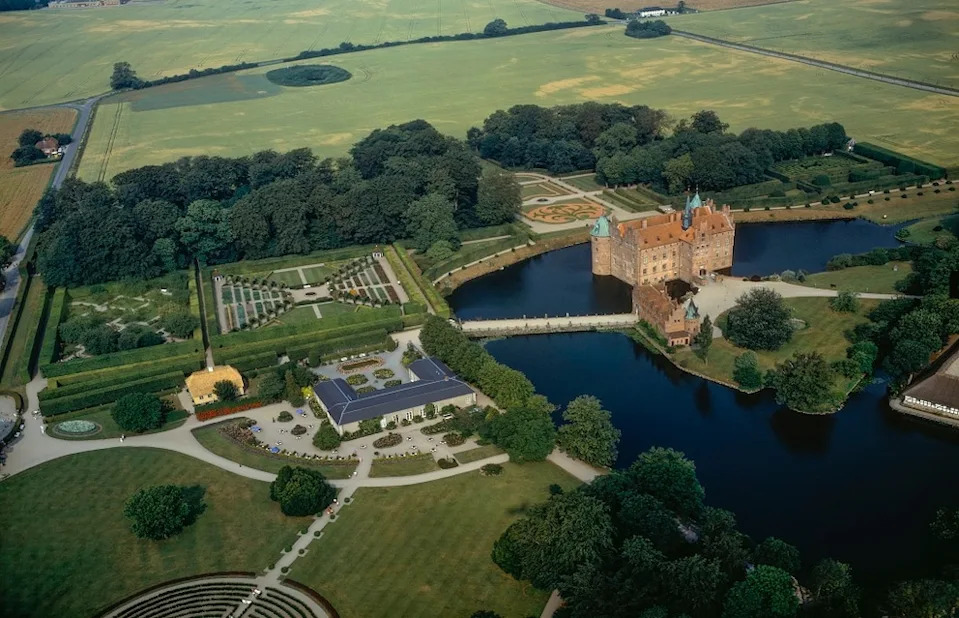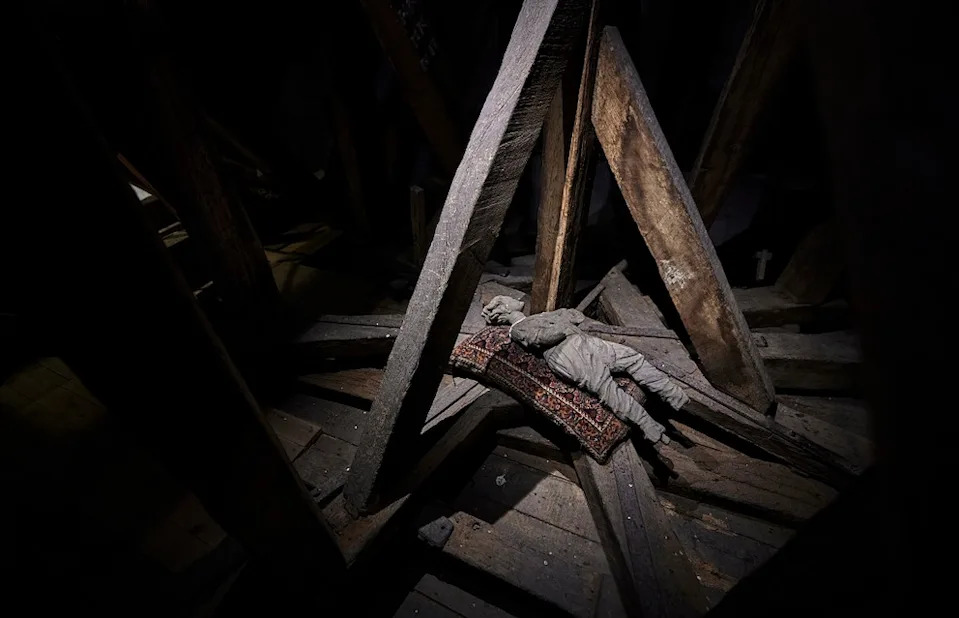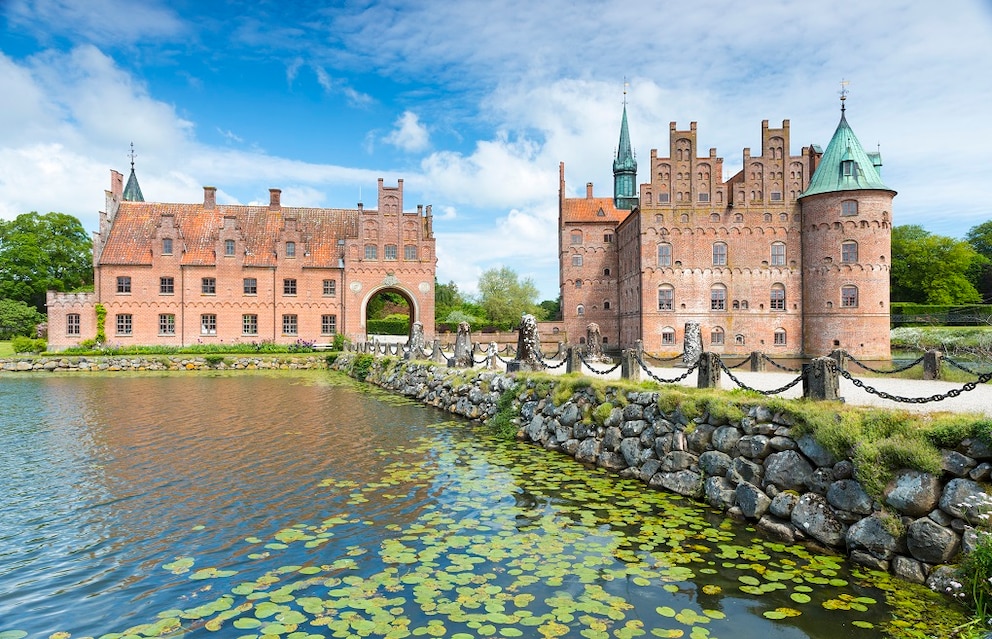On the Danish island of Funen lies one of the most magnificent castles of our neighboring country. Egeskov Castle, as it is called, is inhabited year-round and yet accessible to visitors.
On Denmark’s third-largest island, Funen, stands one of the most beautiful castles of the Scandinavian state, built nearly 500 years ago. Surrounded by a wide moat and expansive parklands, Egeskov Castle is one of the most splendid buildings of its kind in our neighboring country. Although it has been inhabited year-round by a noble family for nine generations, both the building and its numerous attractions are open to visitors. This is likely to be exciting not only for architecture and history enthusiasts but also for fans of the eerie. Indeed, there are some spooky things to discover there.
Lene Pedersen, spokesperson for Egeskov Castle, explains to TRAVELBOOK: “The nobleman Frans Brockenhuus, one of the most educated men of his era, had the castle built by 1554. It was intended as a fortress, as a civil war was raging in Denmark at the time.” The massive building was therefore erected in the middle of a lake on wooden stilts. This is also how it got its name, as “Egeskov” translates from Danish to “oak forest.” According to legend, an entire oak forest was felled to build the castle.
The Ghost of the “White Lady”
In 1569, Brockenhuus’ son Laurids took over Egeskov Castle from his deceased father. He is also associated with one of the darkest stories surrounding the place. He locked his own daughter, Rigborg, in her room for several years after she became pregnant from a premarital affair with a young soldier before the marriage was formalized. Today, numerous media outlets repeatedly report that the young lady’s ghost allegedly haunts the castle as the “White Lady.” Pedersen cryptically says, “What you don’t know can’t hurt you. But if there really are ghosts here, they definitely keep to themselves.”
In the following centuries, Egeskov Castle changed hands several times until 1784, when it was acquired by the bailiff and privy councilor Henrik Bille. His successors, Count Michael Ahlefeldt-Laurvig-Bille and Princess Alexandra of Sayn-Wittgenstein-Berleburg, currently inhabit the castle in the ninth generation. And already in the 1960s, the building underwent perhaps its greatest transformation. During this time, its owners turned it from a purely private residence into a publicly accessible attraction. Since 1961, anyone can visit the expansive parklands with their 17 different themed gardens. Since 1982, the castle itself has also been open to the public.
Also interesting: Moosham Castle: Austria’s Gruesome Witch Castle
A Palace for the Elves

A bird’s-eye view reveals the dimensions of the estate surrounding Egeskov Castle
There is definitely a lot to see here, which is why Pedersen recommends visitors allocate at least five hours. First, there’s Egeskov Castle itself, whose rooms today house numerous exhibitions. These include items from the castle household, old dresses of the castle ladies, a collection of hunting trophies, and weapons. Visitors can start a digital castle guide using their smartphones, accessible on the official site of the place. And then there’s a particularly magnificent palace right in the castle.
This refers to an incredibly detailed dollhouse that the English painter Sir Nevile Wilkinson, then living in Ireland, built himself from 1907 to 1922. His daughter Guendolen told him one day that she had seen elves in the garden and wished for a beautiful home for them. Today, “Titania’s Palace,” as it is called, is owned by the Lego Foundation and can be admired at Egeskov Castle as a loan. Another bizarre mascot also plays an important role in the Danish fairy-tale building. This is a creature that visitors can “meet” in one of the towers of the building.
Also interesting: Frankenstein Castle: Birthplace of a Horror Legend
An Eerie Patron Saint

This eerie doll has lain as a kind of patron saint in an attic of the castle for unknown times
This refers to a wooden doll that lies on a pillow in a tower attic. It represents a small boy in life size and is something like an eerie guardian spirit of Egeskov Castle. “We also call it ‘The Soldier’ or ‘The Watchman,’” says Pedersen. “No one knows exactly when it came here. Probably during renovations in the 19th century.” And this doll has a very special protective function, according to the castle’s superstition. It is said that the building would be destroyed on a Christmas Eve if it were ever removed. “So it remains a popular symbol of Egeskov’s history and spirit.”
Those who prefer less spooky attractions will find plenty to enjoy in the 20-hectare parklands around Egeskov Castle. Some of the hedges, which total seven kilometers in length, date back to 1730. A team of gardeners spends 800 hours annually trimming them. Each generation of owners adds a personal touch to the gardens. These have won numerous awards, including the English Garden, the Renaissance Garden, and the Princess’s Garden, which in turn includes several themed gardens. Car enthusiasts will also be thrilled, as the castle houses the largest private vintage car collection in all of Denmark.
Also interesting: Gravensteen Castle: Belgium’s Torture Castle
The Castle as a Festival Backdrop
Additionally, there is a large playground and a treetop path. Every year, Egeskov Castle also transforms into a unique venue for music and culture fans when the “Heartland Festival” takes place here. Since 2016, tens of thousands of revelers have gathered on the grounds for a few days in front of the incomparable backdrop. “Over the years, it has become one of Denmark’s most popular festivals,” says Pedersen. Those who wish to visit the castle themselves have the opportunity to do so daily throughout the year. However, since opening hours vary by season, it is advisable to check the official website before visiting.
Also, the castle itself is not open to the public year-round. Adults currently pay 265 Danish kroner for a ticket, which includes access to the building, parks, playground, and exhibitions. This is equivalent to a hefty 35 euros. Children aged 4 to 12 also have to pay, with a fee of 160 DKK, or about 21 euros. Please refer to the official website for group and annual pass prices. Pedersen says, “In Egeskov, you don’t just enter a building, but a living home with an authentic atmosphere.”
The post Denmark’s fairytale water castle, Egeskov, boasts a nearly 500-year history. appeared first on TRAVELBOOK.
